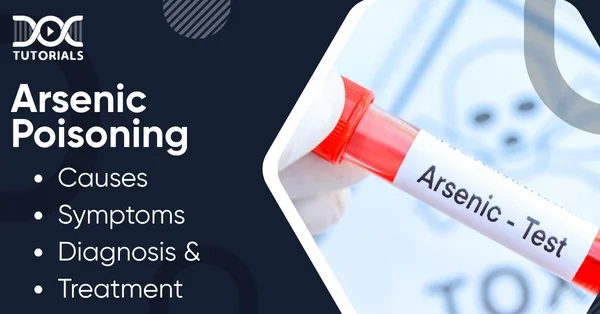Arsenic Poisoning: Causes, Symptoms, Diagnosis, and Treatment

Arsenic poisoning happens when someone is exposed to high levels of arsenic, a toxic element found in contaminated water, food, air, or industrial products. Chronic low-dose exposure over time can lead to several health issues, such as an increased risk of cancer and other diseases. Meanwhile, an acute high-dose exposure can lead to death.
Understanding arsenic poisoning is critical for postgraduate medical aspirants as it equips them with the necessary knowledge to identify, diagnose, and manage such life-threatening conditions effectively, ensuring timely intervention in emergency scenarios.
Keep reading for detailed insight!
What is Arsenic Poisoning?
Arsenic poisoning occurs when an individual ingests or is exposed to high levels of arsenic. This usually occurs via contaminated food, air, soil or groundwater, and a majority of the cases occur in industrial or agricultural areas.
Ingesting toxic forms of arsenic leads to increased permeability of small blood vessels, causing inflammation and necrosis of the intestinal mucosa. These effects present as haemorrhagic gastroenteritis, fluid loss, and hypotension.
This medical condition shares the features of other heavy metal poisonings, like lead and mercury, and chronic exposure can lead to serious health issues and even death if not treated immediately.
What are the Stages of Arsenic Poisoning?
Arsenic poisoning progresses through different stages, depending on the level and duration of exposure. Here’s how it typically unfolds:
- Acute Poisoning: Acute arsenic poisoning occurs when a person is exposed to a high dose of arsenic over a short period, usually through ingestion, inhalation, or skin absorption. It can lead to rapid and severe symptoms.
- Subacute Poisoning: This usually results when arsenic poison is administered in small doses at regular intervals to cause death by gradual prostration. Symptoms may develop over several days.
- Chronic Poisoning: This is much more insidious. Chronic poisoning may occur among persons engaged in smelting and refining ores and subliming white arsenic in manufacturing sheep dips, weed killers, paints, dyes, cosmetics, drugs, etc.
It’s essential to keep in mind that chronic poisoning can occur after acute poisoning, particularly when a person has recovered from a substantial dose of arsenic exposure.
What are the Causes and Risk Factors of Arsenic Poisoning?
Several factors can increase the risk of arsenic poisoning, especially chronic exposure. Here are the key risk factors:
- Contaminated Drinking Water: Groundwater in certain regions is naturally high in arsenic, leading to long-term exposure.
- Occupational Exposure: Industries such as mining, agriculture, and glassmaking may expose workers to arsenic dust or fumes.
- Dietary Intake: Some foods like rice, seafood, and mushrooms can contain small amounts of arsenic, mainly if grown in contaminated soil.
- Use of Traditional Medicines: Certain herbal remedies and ayurvedic treatments may contain arsenic compounds.
- Living Near Industrial Sites: People who live near factories, smelters, or hazardous waste sites may encounter higher arsenic levels in the air, soil, or water.
- Smoking and Tobacco Use: Tobacco may contain trace amounts of arsenic, increasing exposure over time.
What are the Symptoms of Arsenic Poisoning?
Arsenic poisoning symptoms usually appear within 10 minutes to 1 hour after ingestion, but may be delayed if arsenic is taken with food.
- Acute Poisoning
Initial Signs:
- Metallic taste in the mouth
- Garlic-like odour in the breath
- Dry mouth and difficulty swallowing (dysphagia)
Gastrointestinal Symptoms:
- Severe nausea and vomiting
- Colicky abdominal pain
- Profuse diarrhoea with rice water stools
- Possible presence of blood in stools
- Stools may contain shreds of mucous membrane and fragments of poison
Systemic Effects:
- Intense thirst, but drinking water worsens vomiting
- Painful leg cramps due to severe dehydration
- Suppressed urine output, indicating kidney involvement
- Subacute Poisoning
Early Symptoms:
- Dyspepsia (indigestion)
- Cough and tingling sensation in the throat
Gastrointestinal Distress:
- Vomiting and purging (severe diarrhoea)
- Abdominal pain and tenesmus (painful straining during bowel movements)
- Bloody stools
Neurological and Systemic Effects:
- Depression and languor (general weakness and fatigue)
- Neuritis symptoms (nerve inflammation, leading to burning or tingling sensations)
- Severe muscle cramps, causing restlessness
- Collapse, which may progress to death in severe cases
- Chronic Poisoning
Initial symptom:
- Toothache
Progressive Oral Effects:
- Swelling of the jaw
- Loosening of teeth
- Necrosis of the gums
- Sequestration of bone in the mandible (phossy jaw)
Systemic Manifestations:
- Anorexia (loss of appetite)
- Weakness and fatigue
- Joint pains
- Hepatic damage
What is the Diagnosis Process for Arsenic Poisoning?
Samples from patients are collected at the earliest to diagnose the cause:
- Urine: Excretion of arsenic >50 ug/L in 24 h urine is indicative of recent poisoning. Metabolites of arsenic, including methylarsonic acid and dimethylarsenic acid, may be recovered in a urine specimen.
- Hair: Arsenic >75 ug% suggests poisoning. Levels between 1.0 and 3.0 mg/kg indicate acute poisoning, while ” 0.1-0.5 mg/kg” indicates chronic poisoning.
- Nails: Presence of >100 μg% of arsenic is suggestive of poisoning.
- X-ray: Radiopaque sign on abdominal X-ray.
- ECG: QRS broadening, QT prolongation, ST depression, and T-wave flattening.
- Pathological Tests: Blood (serum arsenic >0.9 μg/dL), stool, liver, kidneys, and bones show arsenic. As with all heavy metal poisoning, microcytic hypochromic anaemia is common.
What are the Treatment Options for Arsenic Poisoning?
Ensuring hemodynamic stability is crucial, and substantial volumes of crystalloid solutions may be necessary to compensate for significant gastrointestinal losses, such as vomiting and diarrhoea. Arsenic poisoning treatments may include:
- Gastric Warm Lavage
It involves inserting a large tube through the mouth or nose into the stomach, aspirating the stomach contents, and then flushing the stomach with warm saline or water.
- Demulcents
Demulcents soothe and protect mucous membranes by forming a protective barrier. While they may help alleviate irritation caused by arsenic poisoning, they do not treat or remove arsenic from the body.
- Whole Bowel Irrigation
Done with polyethylene glycol, which may be adequate to prevent gastrointestinal tract (GIT) absorption of arsenic.
- Antidote
British anti-Lewisite (BAL) or dimercaprol is given in a dose of 3-5 mg/kg IM 4 hours a day for 2 days, 6 hours a day for 1 day, and 12 hours a day for 10 days.
Oral succimer (DMSA), 10 mg/kg every 8 hours for 10 days, or dimerval, 200 mg IV 4 hours daily, until the oral product can be given in a dose of 100 mg TDS or QID, may be used instead of BAL.
- Chelating Agents
The primary treatments for arsenic poisoning include chelating agents like dimercaptosuccinic acid (DMSA) and dimercaptopropane sulfonate (DMPS), which help remove arsenic from the body.
- Purgatives
Castor oil or magnesium sulfate is given to remove unabsorbed arsenic poison from the intestínes.
- Glucose-saline with Sodium Bicarbonate
Helpful to combat shock and improve alkali reserve.
- Hemodialysis
It may be done along with exchange perfusion.
FAQs About Arsenic Poisoning
- Is arsenic poisoning linked to cancer?
Long-term exposure is associated with skin, bladder, lung, and liver cancers. Arsenic is classified as a Group 1 carcinogen by the World Health Organisation (WHO).
- Can arsenic poisoning be reversed?
Early intervention can reduce arsenic levels in the body, but chronic exposure may cause irreversible damage to organs and increase cancer risk. Chelation therapy can help remove arsenic in acute cases.
- How does arsenic poisoning affect children?
Children exposed to arsenic may experience growth delays, cognitive impairment, and increased risk of developmental disorders. Exposure during pregnancy has been associated with low birth weight and high risk of infant mortality.
- What is the fatal dose of arsenic poisoning?
A dose of 60-120 mg is usually considered fatal, though vomiting may permit recovery from much larger doses.
Conclusion
Arsenic poisoning is a serious health concern that can lead to both acute and chronic complications if left undiagnosed or untreated. Understanding its sources, symptoms, and treatment options is crucial for preventing long-term damage. Whether it’s through contaminated water, industrial exposure, or certain foods, awareness and early intervention remain the best defences against this toxic threat.
Mastering such high-yield topics is essential for medical students preparing for competitive exams like NEET PG. Platforms like DocTutorials offer comprehensive guidance via video lectures, faculty-reviewed question banks, quick revision programs, and more, to help you stay ahead in your preparation journey. Enrol in our NEET PG courses today!
Latest Blogs
-

NEET PG Exam 2025- Date, Pattern, Marking Scheme, Subject Wise Weightage, and Exam Mode
NEET PG Exam 2025 is the ultimate gateway for medical graduates aspiring to pursue postgraduate courses in medicine, including MD,…
-

INI CET Exam 2025: Your Roadmap to Success – Key Topics, Strategies, and Lessons from Last Year’s Papers
The INI CET exam is more than just a test; it’s a significant milestone for many medical students aiming to…
-

INI CET Exam Success: Previous Year Question Papers & Ultimate Guide – INI CET PYQ
One can feel overwhelmed while preparing for the INI CET (Institute of National Importance Combined Entrance Test). A vast syllabus,…





